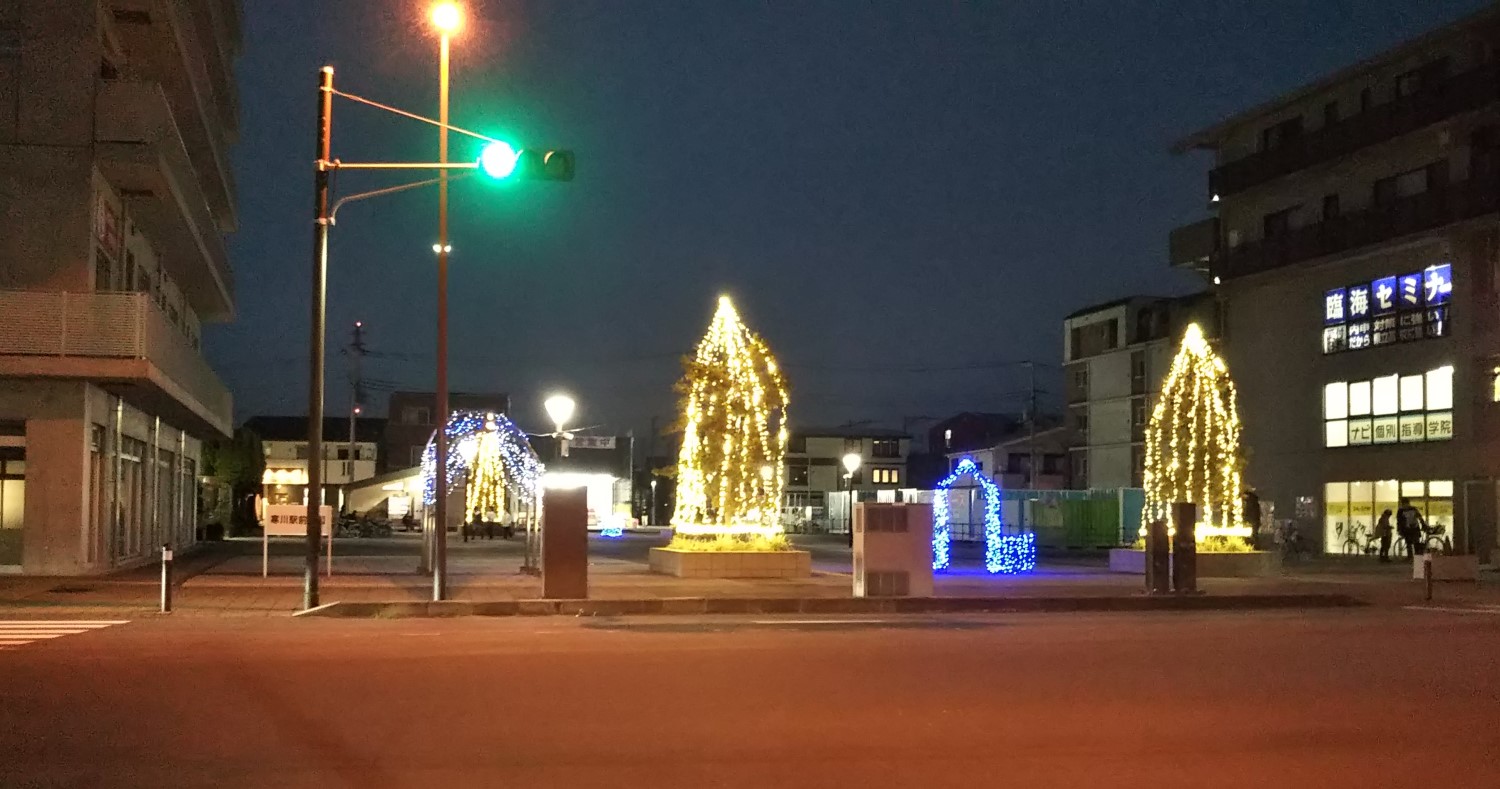CW86 November, 2023
Survey results on waste collection
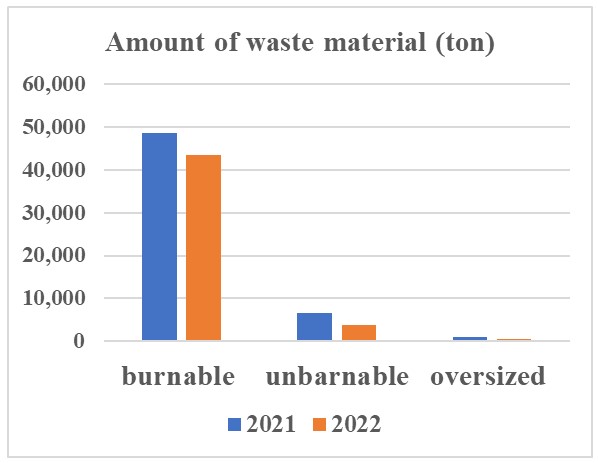
The city hall has surveyed citizens’ opinions about waste collection, and has posted the results on its website*. The city sent questionnaires in May 2023 to 3,000 citizens aged 18 and older and 1,000 companies with 10 workers and more. The citizens and companies were randomly selected from two registers. It collected completed questionnaires from 67.4% of the citizens and 36% of the companies. The results were as follows.
❶ The city began to charge for waste collection in April 2022. Asked about the reduction of waste, 47% of respondents answered they had more interest than they did in 2021, and 29% said they had been interested in the reduction since before 2021. In 2022, the amounts of burnable, unburnable, and oversized wastes decreased by 10.5%, 42.8% and 30.7% from 2021, respectively. See the figure above. Quite a few respondents said they more thoroughly separated and sorted waste. Some said they became more conscious of food waste when they went shopping or did the cooking.
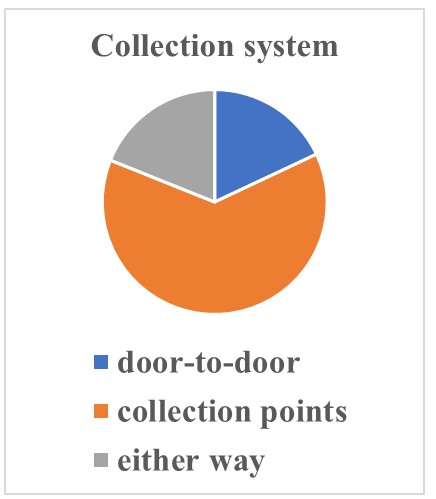
➋ Asked about a door-to-door waste collection, 17.5% of respondents preferred the door-to-door collection, but 61.3% chose the current system, in which waste is collected at collecting points. And either way was fine for 10.8%. See the pie chart on the left. Many respondents who preferred the door-to-door collection said the collection system would liberate them from the task of clearing collection points and conveying waste to the spots. On the other hand, many respondents who chose the current system said there was no need to spend a lot of money on waste collection.
The city also allowed other citizens’ participation through the internet. The results were similar to those of respondents except more participants preferred the door-to-door collection. The city will report a plan on the waste collection in March 2024.
* 「ごみ有料化及び戸別 収集に関するアンケート調査(無作為抽出アンケート)報告書」
Flu cases at designated hospitals in the city have exceeded the advisory level.
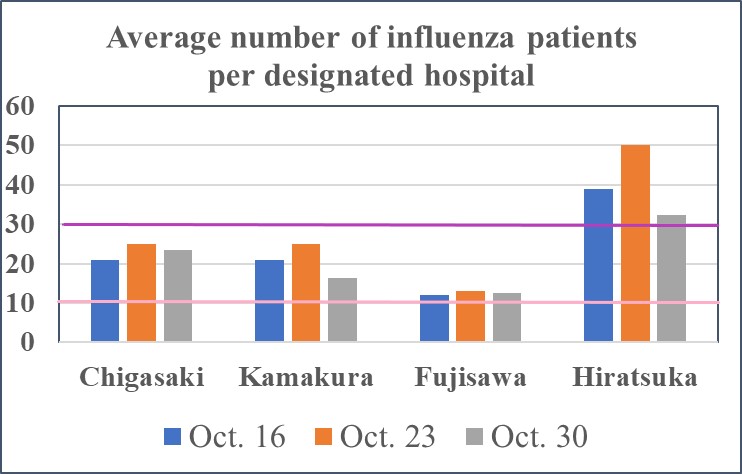
The average number of weekly flu cases per designated hospital in the city has exceeded the advisory level (10 cases) and is nearing the alarm level (30 cases). The figure above shows the infection statuses in the Oct. 16 (Mon) - Nov. 5 (Sun) period in Chigasaki and its neighboring cities.
The advisory level indicates that a flu outbreak may occur within four weeks, and in its termination phase, the epidemic has not subsided yet. The alarm level indicates that a mass outbreak has occurred or is continuing.
The age bracket from five to 14 years old accounts for the major part of patients.
Source: 2023/2024シーズン神奈川県 インフルエンザ情報 令和5年(9)44週|神奈川県衛生研究所 (pref.kanagawa.jp)
In all elementary schools in Chigasaki, seven classes were closed in the Oct.16 - 22 period, 16 classes in the period of the 23rd - the 29th, and 11 from Oct. 30 to Nov. 5. (Source: the city HP)
Flowers of the Season: Sarcandra glabra
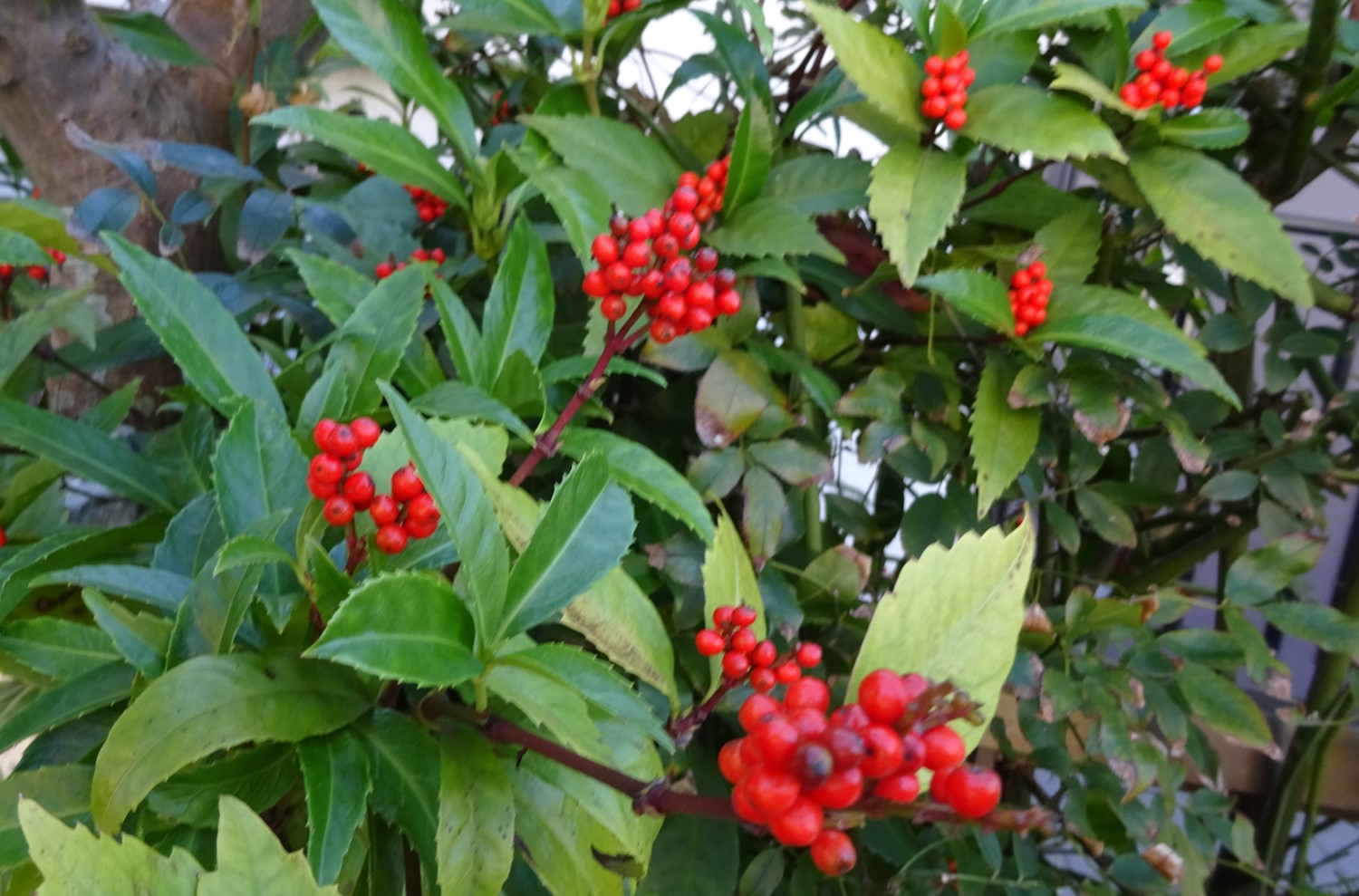
Sarcandra glabra is popular with us as a plant to invite good luck. Therefore, it is used for New Year’s decorations with pine branches and other plants. A pair of Kadomatsu, gate decorations, are placed in front of households and buildings, and arranged flowers are placed in alcoves of private houses and company offices. It is because the plant’s Japanese name ‘Senryou’ means a thousand oval gold coins, and the plant bears plenty of red fruits in winter. The evergreen shrubbery grows naturally in the temperate and tropical zones, for example, on the Korean Peninsula, in China, Malaysia and Japan. Tree height is about 80 cm. Its rhizomes grow new stems every year so we can easily cultivate the plant. The plant is fond of half-shady areas and grows gregariously on forest floors in broad-leaved forests. Its pointed top and toothed leaves show a decussate phyllotaxis arrangement. Greenish yellow flowers having no floral envelop bloom in June and July; their stamens adhere to the back of pistils.
Sarcandra glabra’s flowers were found in the primitive geological stratum (130 billion years ago). In China, dried young leaves are used for herbal tea, which has antibacterial and anti-inflammatory effects.
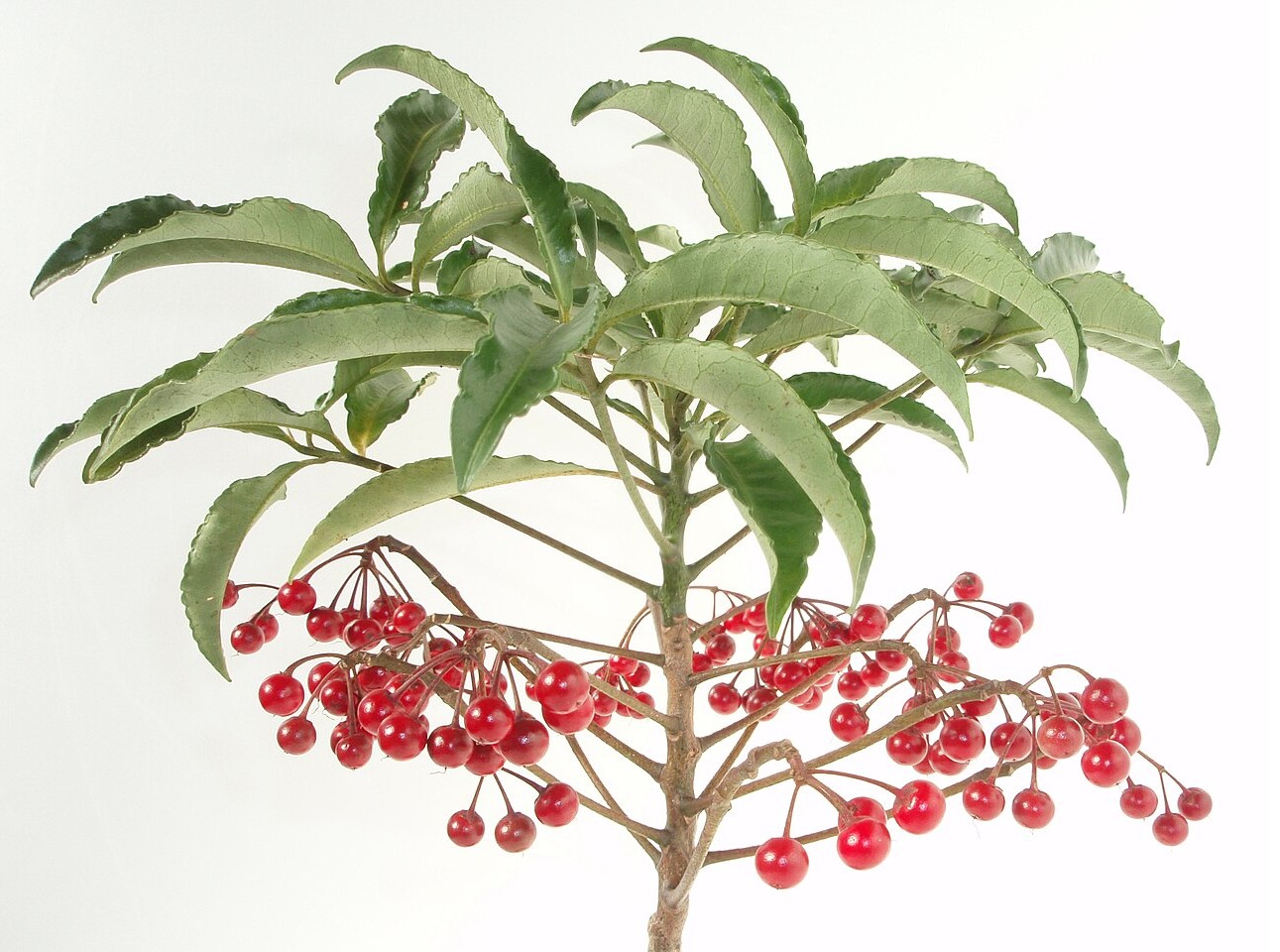
By the way, there is another plant which looks like Sarcandra glabra. Coral bush also bears plenty of red fruits in winter. Coral bush is called ‘Manryou’ in Japanese, meaning ten thousand oval gold coins. But the two plants are different varieties. Sarcandra glabra belongs to Chloranthaceae, and Coral bush to Primuraceae. The former’s fruits are on the leaves, while the latter’s are below the leaves.
History of Chigasaki: Namegaya Village (2)
The Baba family, a direct retainer of the shogun, ruled Namegaya Village until the Meiji Restoration ended the Edo period in 1868. The relation between the Baba family and the village started when Namegaya and part of Chigasaki village were given to Fusakiyo Baba in 1632.

The village shrine of Namegaya was Kanayama Shrine. See the photo above. 新編相模国風土記稿 (the new edition of Sagami province topography) describes Kanayama Shrine as Kanayama gongensha, whose object of worship is an old bronze statue cast on a plate. The shrine and Suwa Shrine of Shimoterao Village were enshrined to Suwa Shrine of Tsutsumi Village. For some reason, however, Kanayama Shrine was separated afterward and moved to the present place.

There are five Koshin towers at the entrance of the approach to the shrine. One of them was built in 1655. The tower has the shape of “a Blue-Faced Vajra with four hands, accompanied by two monkeys”. It is known that the tower was made earlier than the other two of the same design, which are placed in Amanuma and Jukkenzaka. The three towers are designated as the city’s important cultural assets.
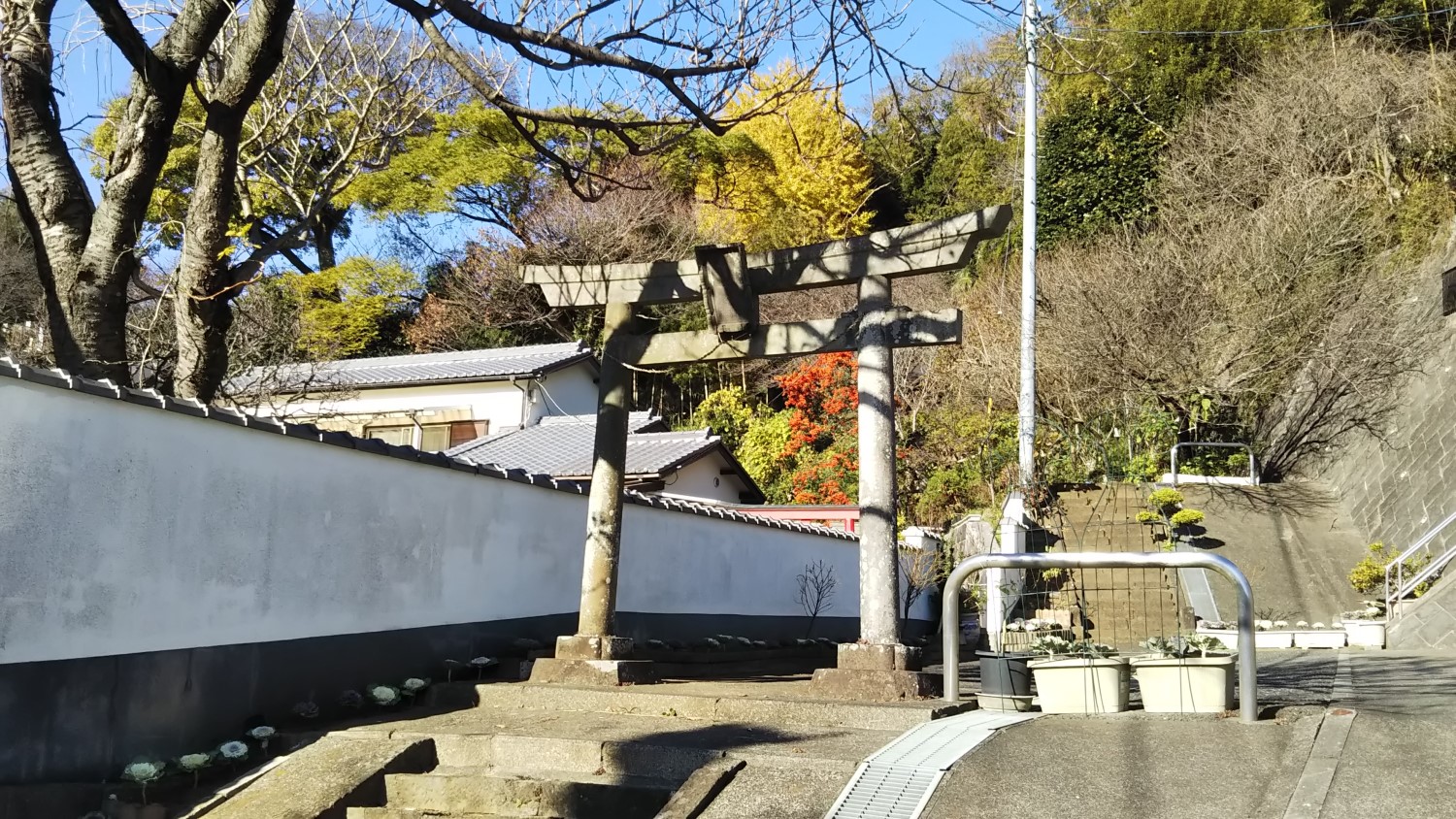
The torii, the gateway, standing over the approach to the shrine has an engraved inscription “文政9年 秋8月“, or Autumn August in 1826. This is the oldest era name of all the inscriptions on the torii in the city. The torii collapsed during the 1923 Great Kanto Earthquake, and was rebuilt in 1929, which is also engraved on the new torii.
There is Hozoji Temple of the Soto sect next to Kanayama Shrine. An elementary school named “時習学舎”, or Jishyu gakusha, opened in the temple in 1873. The school was built based on the new school system enacted by the Meiji government. Its school district spread over the city’s northern part: Namegaya, Serizawa, Tsutsumi, and Shimoterao. But the school was located at the end of the district so that it was moved to Nakaya in Tsutsumi. Its name was also changed to “Tsutsumi school”, which was the forerunner of today’s Koide Elementary School.
Interested in Japanese proverbs?
1) 金が仇の世の中 (KANE GA KATAKI NO YONO NAKA)
KANE means money, GA to be, KATAKI an enemy, NO a postposition, and YONONAKA the world.
People think money can solve almost all problems, but money sometimes causes friction and/or hostility between them. Lending and borrowing money between friends may spoil their friendship. People who dream of being rich overnight mostly suffer serious consequences. High returns are accompanied by high risks. So don’t be mad about gambling.
However, as long as they live within their means, money supports them. By the way, will you buy the Year-end Jumbo Lottery, a little pleasure?
The proverb is in Nenashigusa, or a rootless grass, a humorous book which depicted social conditions satirically. The first part was published in 1763, and the second in 1769.
Its English equivalents are:
●A rich man’s money hangs him oftentimes.
●Money makes friends enemies.
●A man’s wealth is his enemy.
2) 腐り縄にも取り所 (KUSARI-NAWA NIMO TORI DOKORO)
KUSARI means rotten, NAWA rope, NIMO a postposition, and TORI DOKORO merits.
Even rotten rope is useful for some purposes. No matter what the thing is, it will serve the society if it is used appropriately. Today, many people know a slogan for resource conservation-3R: Reduce, Reuse, and Recycle. Reuse is something the proverb indicates. It is a surprise that the people 380 years ago already had consciousness of conservation. Necessity makes people thrifty.
The proverb is in Kefukigusa, (a plant of the rose family or another name for Japanese apricot), which is a collection of haiku in five volumes published in 1645.
Its English equivalents are:
●Nothing so bad as not to be good for something.
●Nothing so bad but it might have been worse.
●Nothing so bad in which there is not something of good.
Invitation to Kamakura (35) - Autumn Colors (Bimonthly serial)

At last, the record-breaking temperatures of this summer have gone although the heat annoyingly lingered even in September - we doubted if autumn was really coming. Much to our delight, however, we have been having moderate and crisp days lately. At this rate, leaves will turn colorful soon, and the scenery in Kamakura will be really out of this world.

For autumn leaf viewing, firstly, it is recommended to visit Hase-dera temple as the best spot. This temple is known as a flower temple throughout the year, but its autumn colors are also gorgeous – maple and gingko tree leaves are a feast for the eyes. The ancient temple built in 736 is planned to be lit up from November 23rd to December 3rd this year. The red and yellow-hued leaves reflected on the surface of the Myochi and Hojo Ponds will create a fantastic atmosphere at night.

Secondly, the autumn beauty of Kakuon-ji temple, which was built in 1218, is also worth a view. It is nestled in a unique geographical feature of Kamakura called Yato, a kind of valley, away from the Kamakura station. We can sense its aesthetic appeal in the medieval period. Many maple trees in the temple will surely impress us, highlighting the different colors of the leaves. This temple is also planned to be illuminated from the end of November to the middle of December.
Thirdly, Ten-en hiking trail is undoubtedly one of the popular spots for autumn leaves. This trail starts from the corner of Kencho-ji temple’s precincts and ends in Zuisen-ji temple through a quiet, narrow path in nature. It takes an average of 2 hours and 20 minutes to complete. Located on the hillside, this trail gives us a far-way view of Mount Fuji. On the way to going down the hill toward Zuisen-ji temple, there is an open place named Shishimai, where the scenery of the sunlight falling onto the ground through the colored leaves will certainly fill our hearts with autumn joy.
Note: The three pictures were taken in the middle of November. Trees were still too early to color. Hopefully the beautiful autumn will come very soon.
Short Essays on Chigasaki-7 The Great Eruption of Mt. Fuji in 1707 (The Middle Ages)
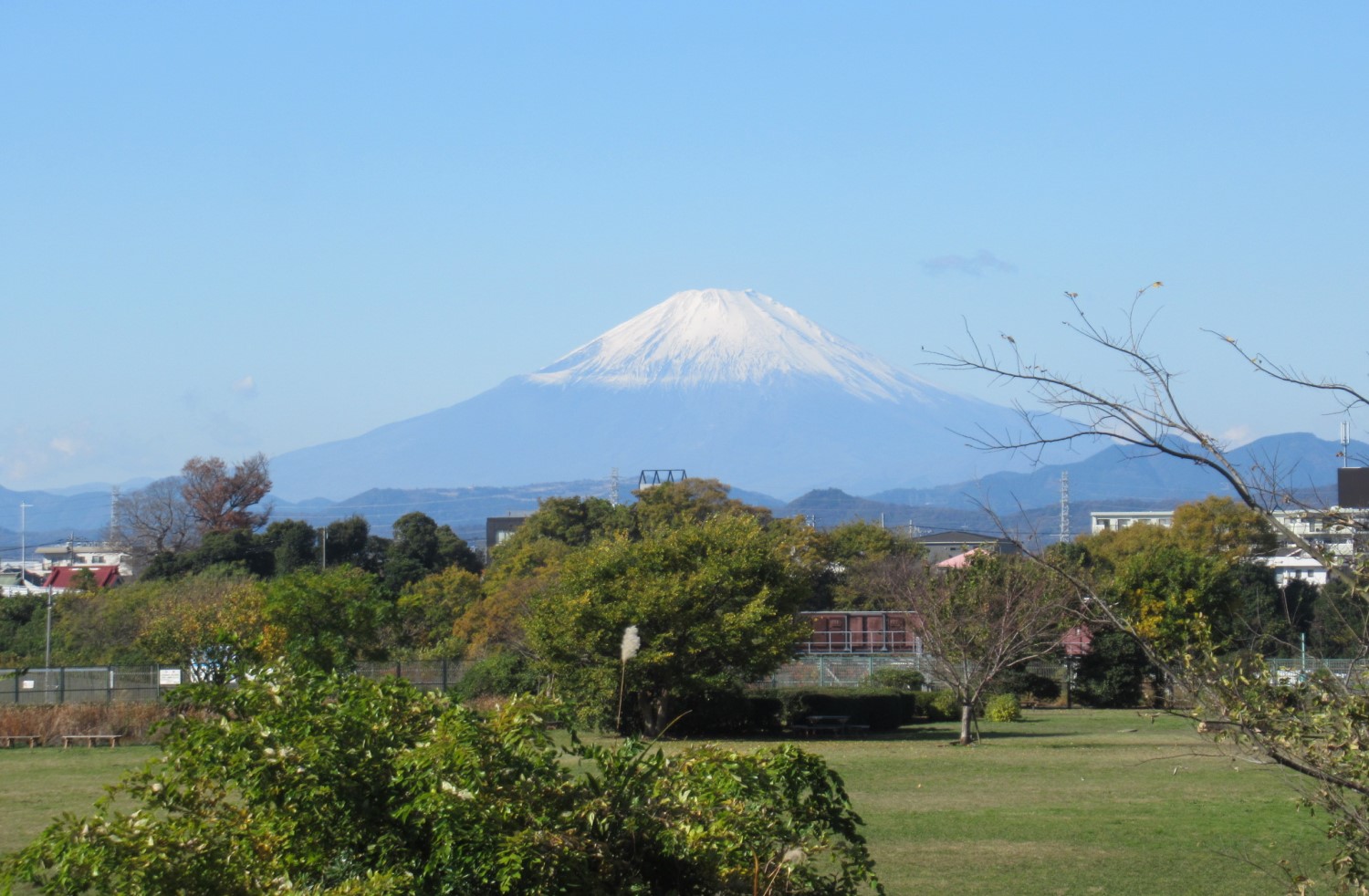
Mt. Fuji from the bank of the Sagami River
The Central Disaster Management Council announced a report on ‘Estimated damage on the Tokyo metropolitan area caused by a large-scale eruption of Mt. Fuji’ in 2020. It said, “If Mt. Fuji erupted now, the area would be covered by ashes, and city functions would be paralyzed.” Mt. Fuji has been quiet for more than 300 years since the last eruption in November 1707. Mt. Hoei coincidentally emerged due to the eruption. So, let’s take a closer look at the circumstance of the 1707 eruption. It’s important to prepare for a possible eruption, because nobody knows when it will erupt again.
In Nishi-tomioka village (today’s Isehara city), the ground started rumbling at noon, and doors and paper screening doors were shaking. It was gradually getting dark outside, so villagers had to make bonfires and light lanterns even in the daytime.
At the Enoshima Island in Fujisawa, a popular shore fishing spot, the ocean became shallow due to lots of sand and rocks from Mt. Fuji, and fishermen weren’t able to catch any seafood such as shrimps, abalones and seaweeds.
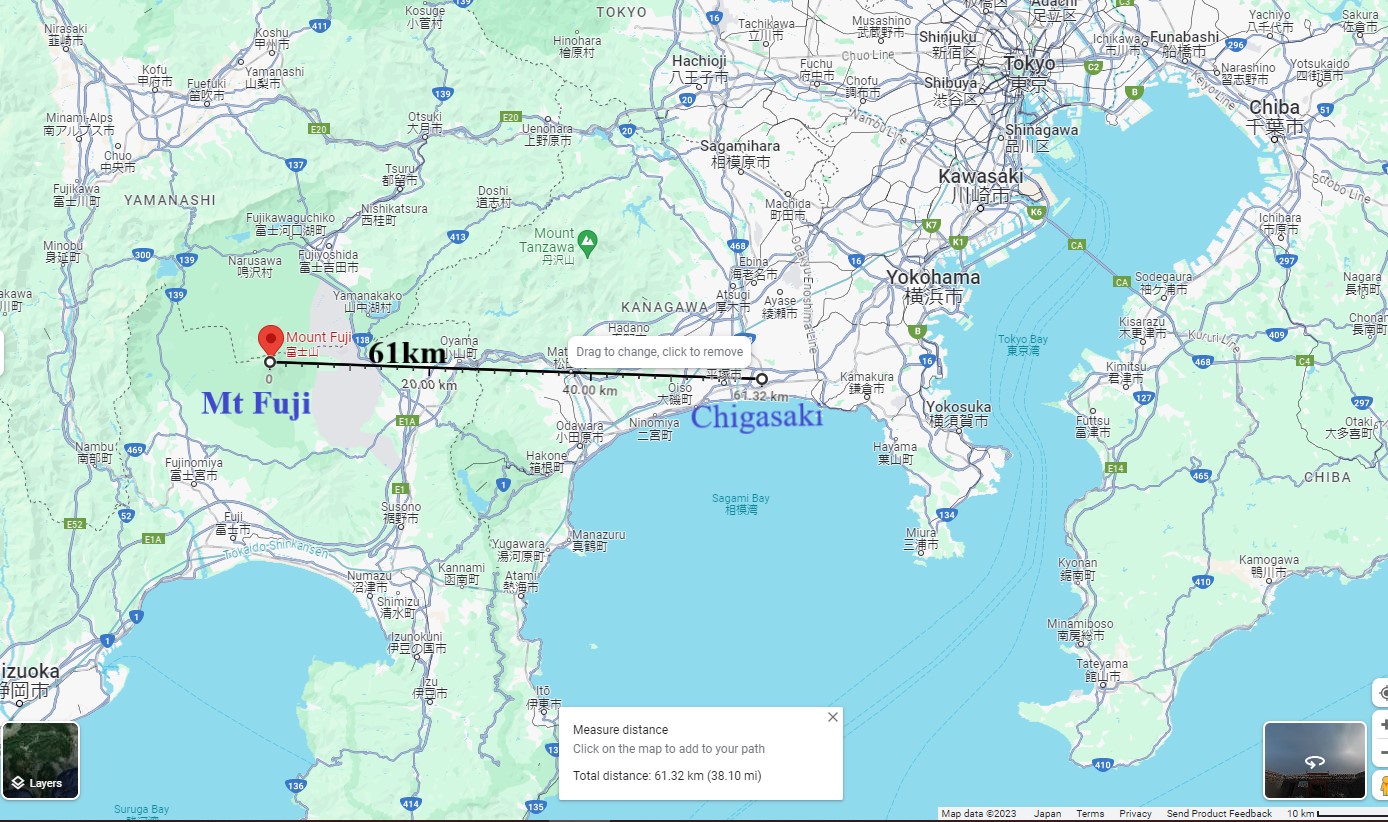
The same phenomena occurred at the Ubajima island in Chigasaki. A southern village, Kowada in Chigasaki, had damage on its rice and barley crops, so financial aid (御救い金) coming from the public subsidies (御公儀) was distributed to the village in the year following the eruption.
A northern village, Serizawa in Chigasaki, keeps a document regarding ‘sand storage (砂置場)’ in which sand and volcanic ash falling on cultivated lands were gathered. Also, the Chigasaki Board of Education preserves a picture of the volcanic ash that accumulated on the approach to the Tsurumine Shrine.
(The source of the essay: Chigasaki People’s Book published by Chigasaki City)
Events in November
Ozu Art at Chigasaki City Museum of Art – Ozu’s eye for beauty
Posters, stills, props, haiku poems on square cards, and more were exhibited at the city museum until November 9 (Thu). These were related to movies made by the noted director, Yasujiro Ozu (1903~1963). His works are filled with an atmosphere of the Showa era so that middle-aged people and over would remember them with nostalgia. It is well known among movie fans that the director often stayed at Chigasaki-kan, a Japanese-style hotel by the sea, for about 20 years from 1937. His team wrote scripts of movies, including 風の中の雌鶏 (A hen in the wind), 晩春 (Late spring), 宗方姉妹 (The Munakata sisters), and 東京物語 (Tokyo story) at the hotel.
The posters showed that stars of the silver screen were distant from ordinary people in those days. The documents he had written indicated he paid close attention to the arrangement of props in the rooms, and clothes of actors and actresses.
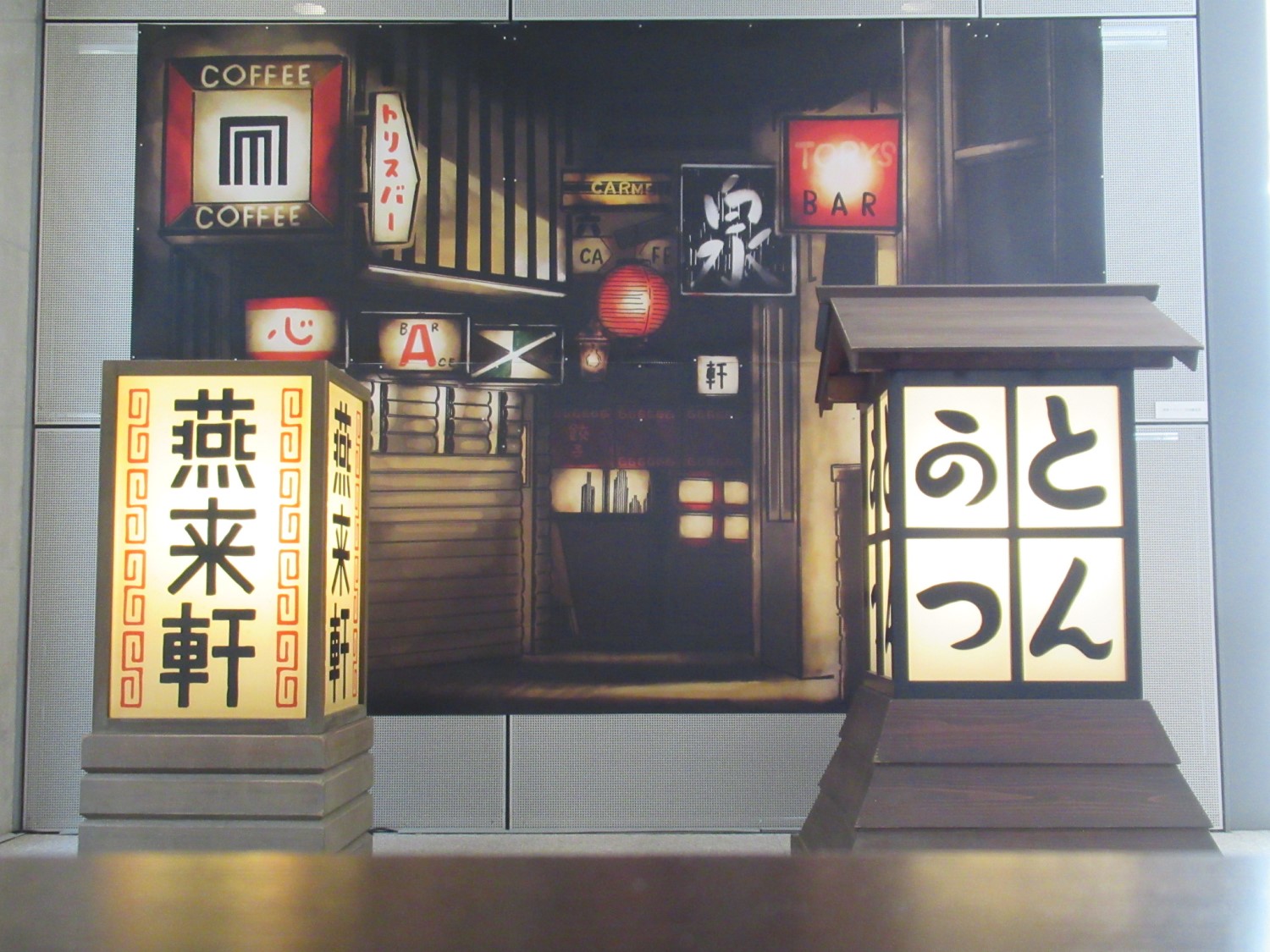
The photo above is a set of the ramen and pork cutlet restaurants in the movie, “The taste of a Pacific saury”. The photo below is the reproduction of his room of Chigasaki-kan, No. 2.
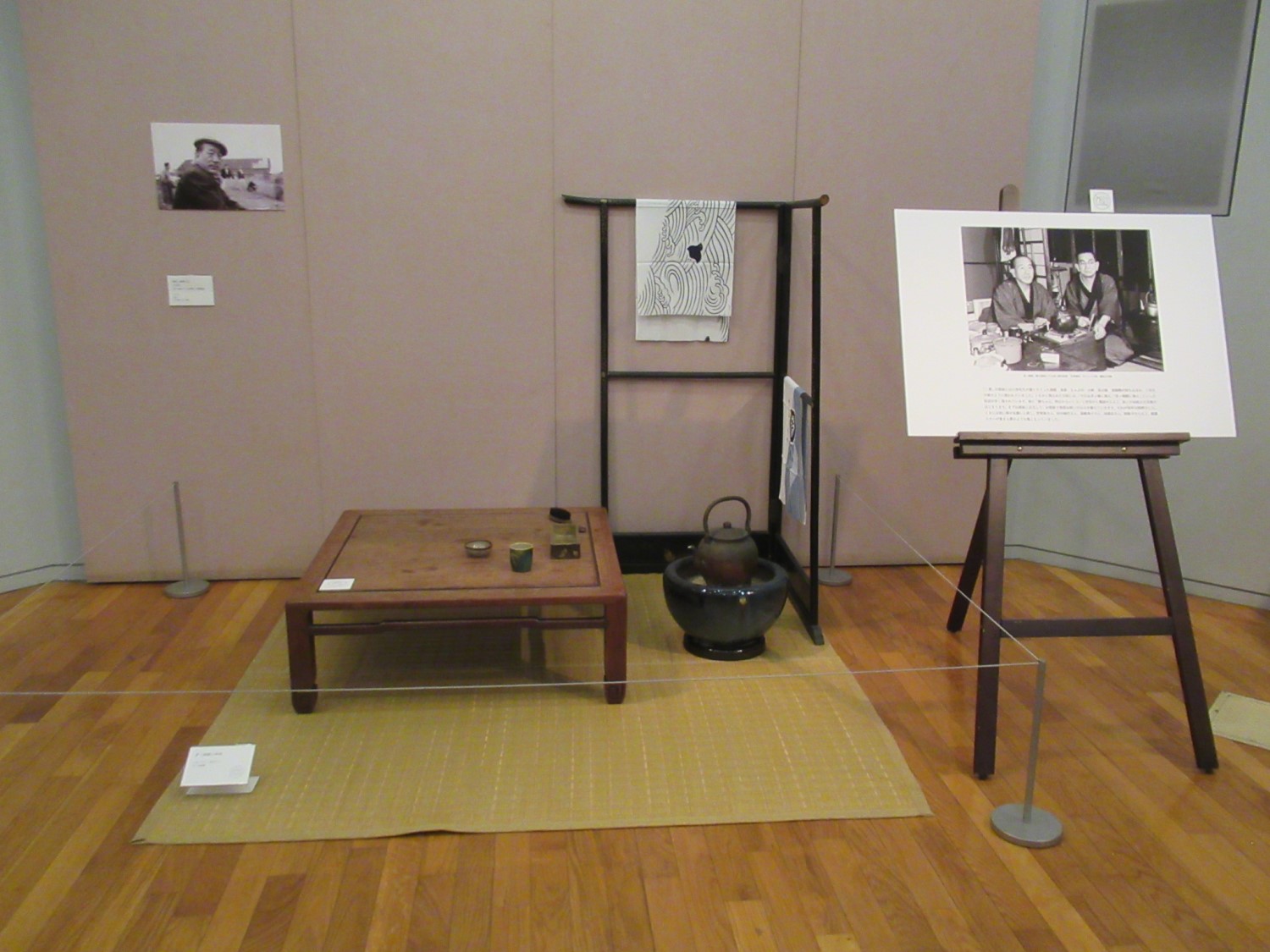
Firefighting and disaster preparedness Festival 2023
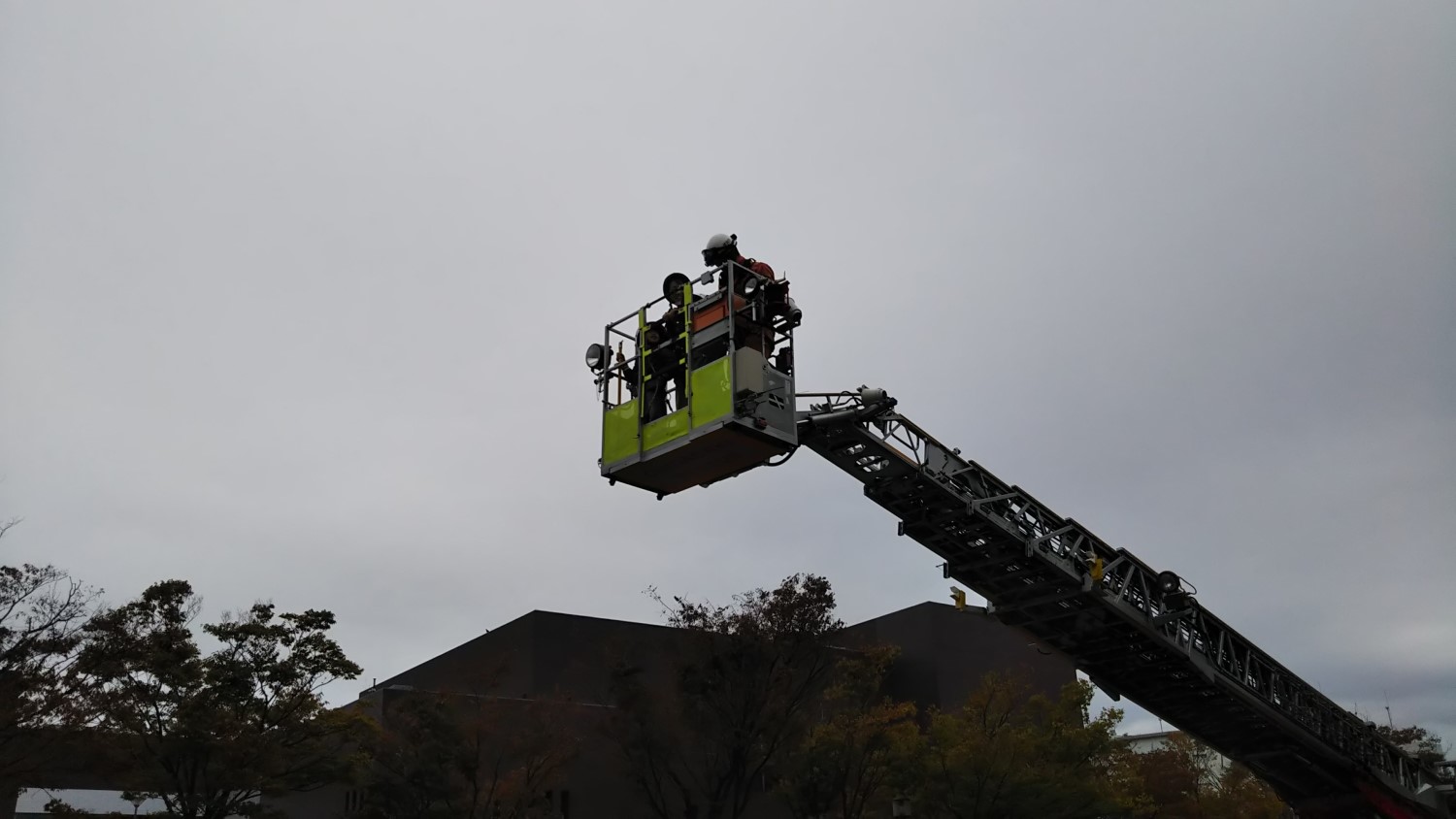
The firefighting and disaster preparedness festival took place at Chuo Koen on November 12 (Sunday). Various experience events were simultaneously held, Children with their parents were waiting in lines for their turns in front of a ladder truck, an earthquake-simulation vehicle, a firefighting corner, a smoke room, and many more. As there were many machines, vehicles and demonstration corners, visitors seemed to understand the activities of firefighters, construction workers and other rescue workers in case of emergency. Not only children but also adults would remember things they learned and practiced on that day for longer, compared to if they had just watched.

Chigasaki Velo Festival 2023
Under a cloudy sky, Chigasaki Velo Festival took place at Chuo Koen on November 18 (Sat). At six areas, different kinds of events - kids’ races, bicycle motocross (BMT) lessons & shows, time trials, mountain bike lessons, basketball shooting, and cheerleading as well as unicycle performances on the main stage - were held simultaneously.
Unicycle performances of the Uchida sister and brothers (the video above), world-famous unicyclists and Japanese champions, were highly praised for their stunts on their cycles and good teamwork.
On the BMT course, a group of five elementary school boys performed jumps and a somersault (the video above). They played almost like circus performers, which excited spectators a lot.
The 63rd Citizen Cultural Festival at Civic Center
Chrysanthemum exhibition at the bicycle parking area from Nov. 1 (Wed) to the 13th (Mon)
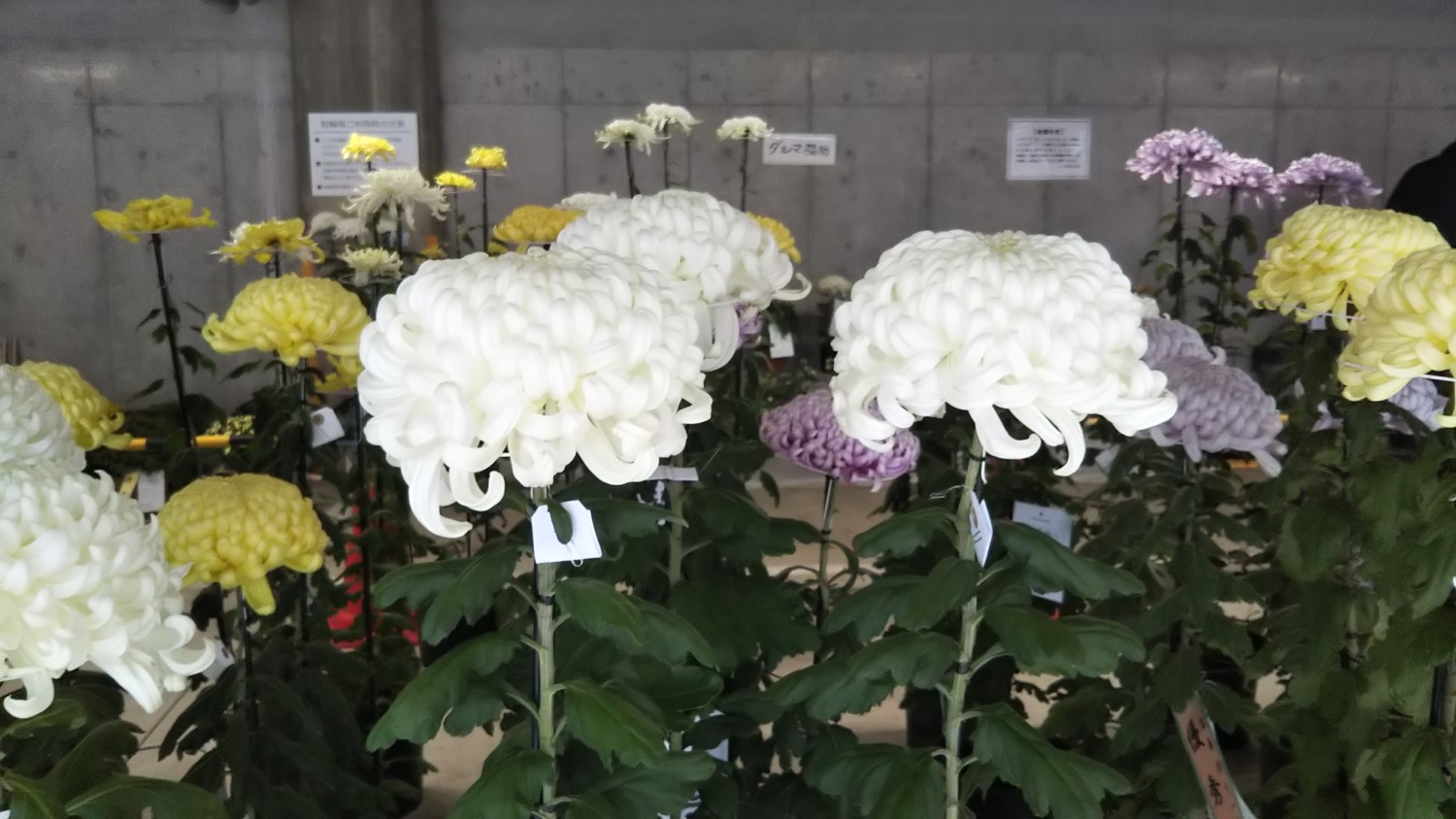
Florists’ chrysanthemums
Chrysanthemum exhibition at the bicycle parking area from Nov. 1 (Wed) to the 13th (Mon)

On exhibition were florists’ and thread chrysanthemums (hereafter mum or mums), and in each of the two categories, there were one-flower and three-flower mums. Three-flower mums make flowers at the ends of three vertical branches spreading out from one stem.

The members of the host group explained to visitors earnestly how to grow the plant, standards of mum contests, and others. Three flowers from one stem, for example, are called “Sanbon jitate (三本仕立)”. The highest flower means Heaven (天), the medium means Earth (地), and the lowest means Human (人). Essential elements for plant growth are N, P, and K (nitrogen, phosphorus, and potassium). They work for different parts of plants: N for leaves, P for flowers, and K for roots. The exhibition provided citizens with an excellent opportunity for learning about the plants.
Handicrafts at exhibition room ABC from Nov. 5 (Sun) to the 7th (Tue)
Akihisa Koyama’s products attracted a lot of visitors. They were small wooden mosaic products such as incense stick boxes, teaspoon boxes, pen cases and more as well as marquetry pictures, that is, pictures made of pieces of wood.
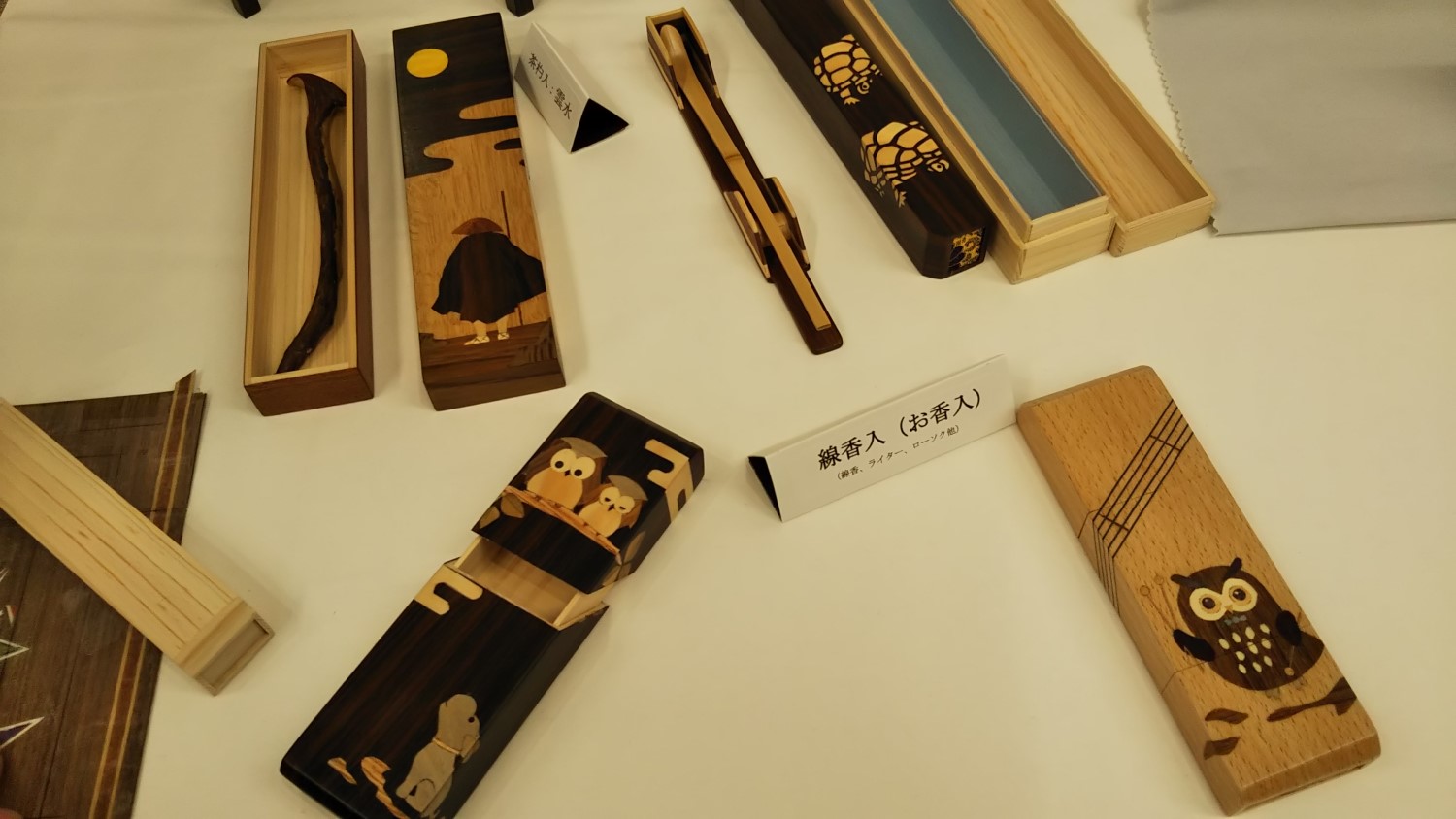
He has liked the warmth of wooden products since he was young. He began to carve images into wood, and engrave words and pictures on wood as a hobby when he turned 60. A few years later, he started marquetry pictures. And then he began to make teaspoon boxes and other small wooden mosaic products for tea ceremonies as he was stimulated by people he met at an exhibition.
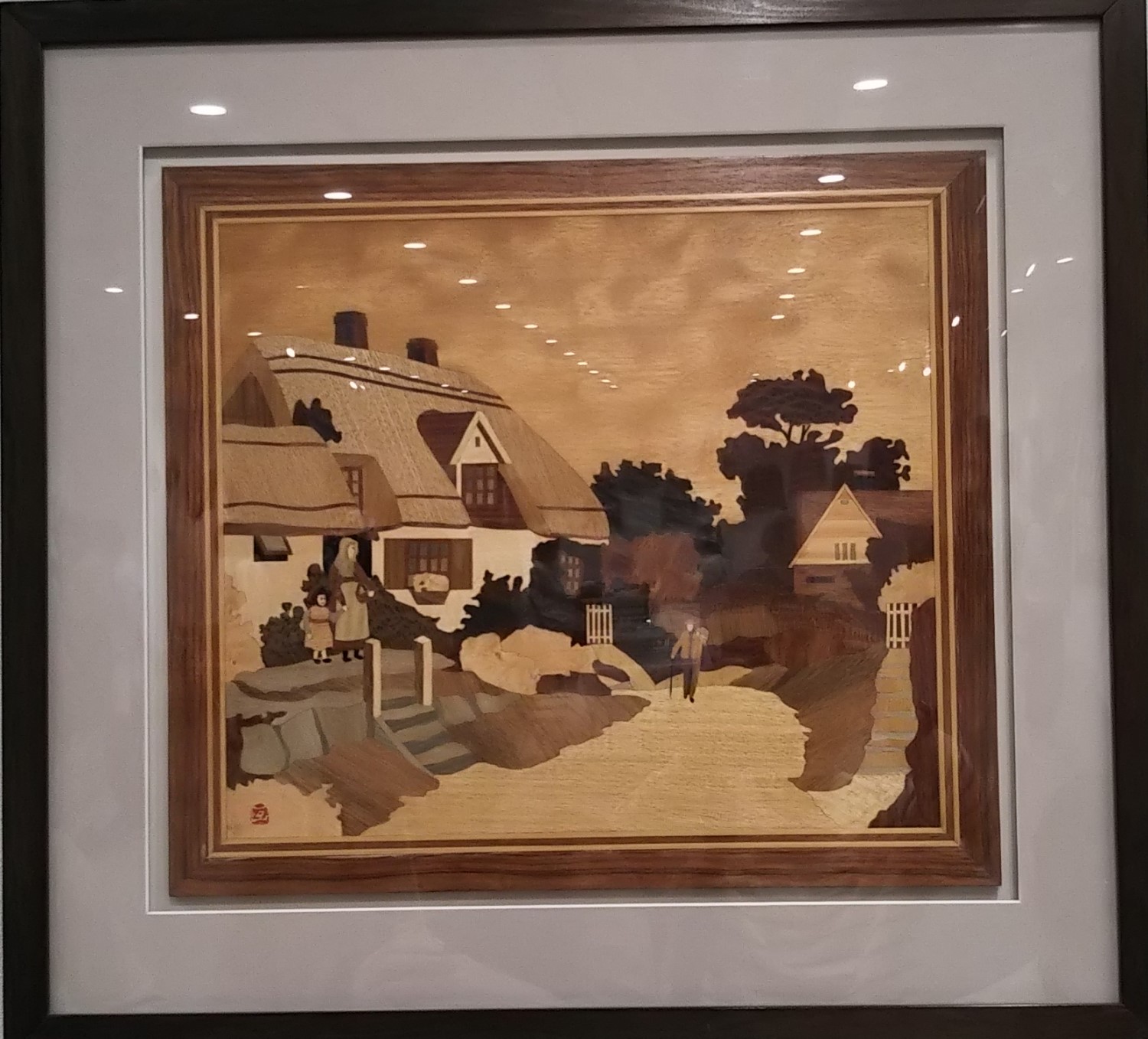
He says it is hard to obtain the thin wooden films which are stuck on the surface of the products. Fortunately, he can enjoy his hobby for at least five years with the stock he has available. He also says he takes a great delight in trying to create new types of products. He makes artistic works from scrap wood, which serves for resource conservation.
Calligraphy – Nov. 10 (Fri) and 11th (Sat) at exhibition room ABC
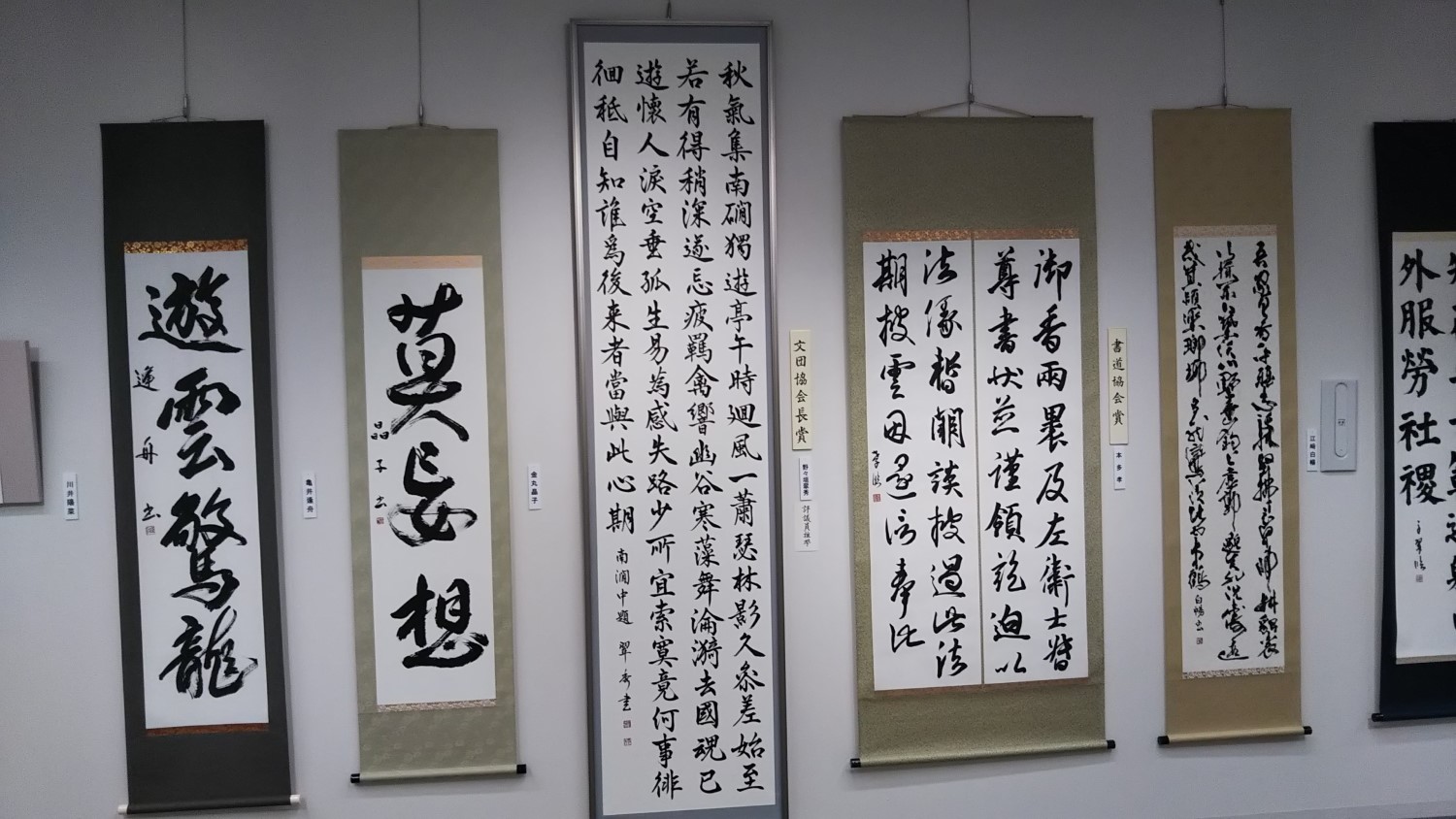
On display were works by ninety calligraphers, consisting of 50 members of the city’s calligraphy association and 40 citizens. Works were written by the printed style, the Japanese cursive style, and many more styles. Personally, the writer is mostly attracted to the beauty of the vertically lined Chinese characters in the printed style.
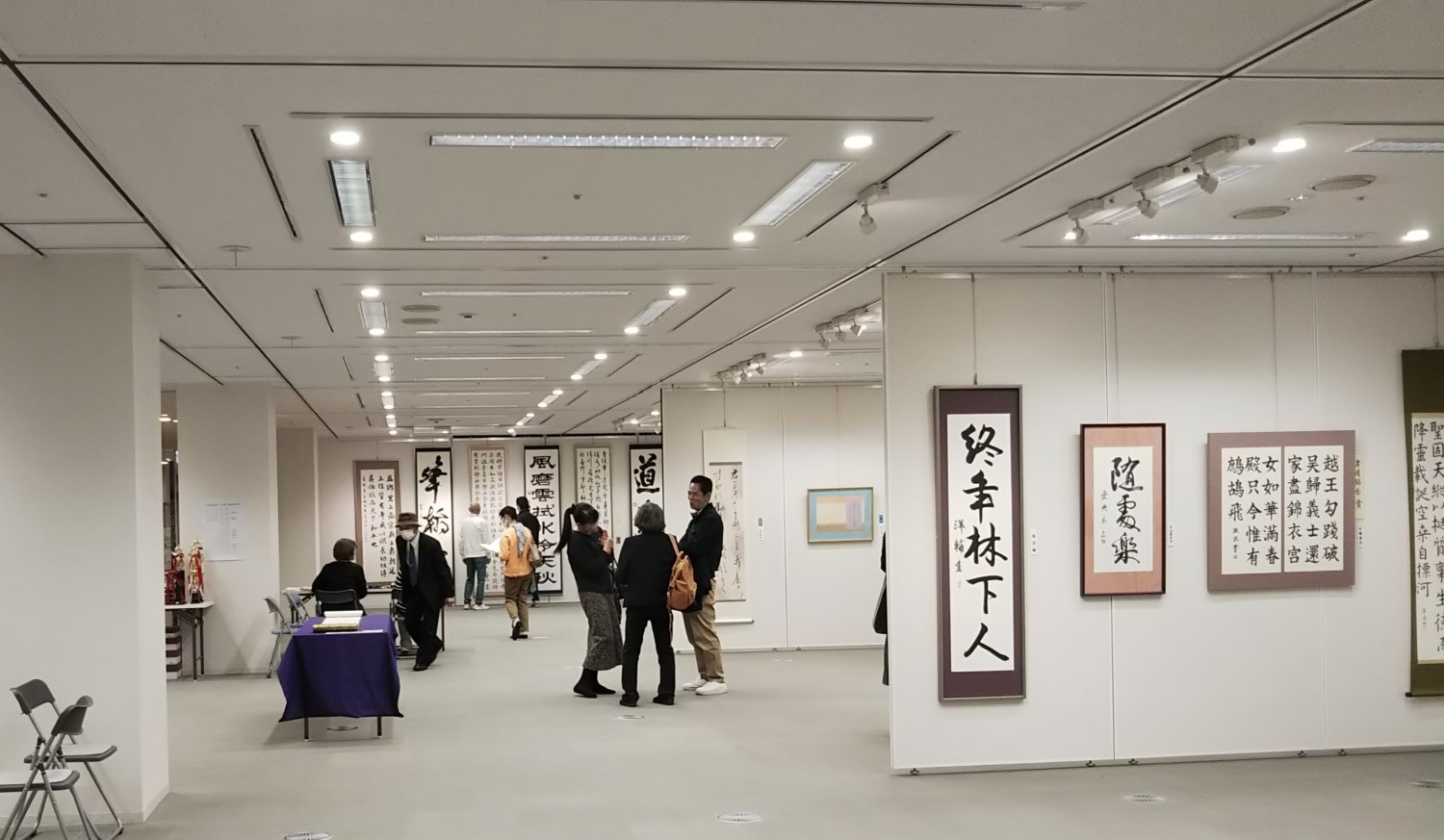
Visitors of all ages dropped by the room all the time, indicating calligraphy may be not showy, but traditional culture, and many people enjoy the activity through their life.
Citizen Gallery (☎ 0467-87-8384) at the exhibition room on the 4th floor of N’EST- CE PAS Chigasaki - Admission free!
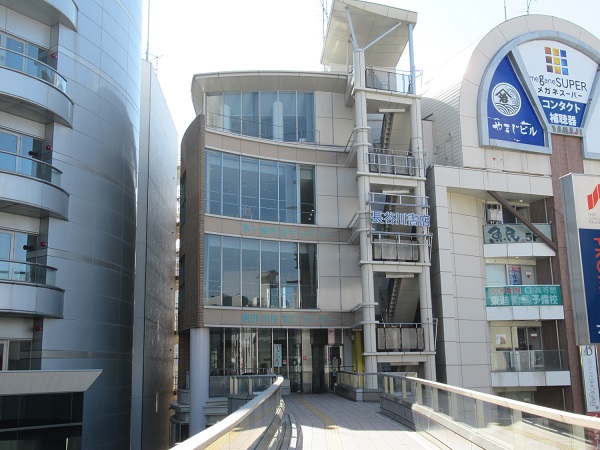
●Picture exhibition by Tansai (light coloring) Chigasaki: Nov. 28 (Tue) 13:00 ~17:00, the 29th to Dec. 2 (Sat) 10:00 ~ 17:00, the 3rd (Sun) 10:00 ~ 16:00
●Photo exhibition “Unforgettable viewpoints” by Culture II Shonan: Dec. 5 (Tue) 13:00 ~17:00, the 6th (Wed) to the 9th (Sat) 10:00 ~ 17:00, the 10th (Sun) 10:00 ~ 16:00
●Picture exhibition by Koichi Sato: Dec. 21 (Thu) 13:00 ~ 17:30, the 22nd (Fri) and the 23rd (Sat) 10:00 ~ 17:30, the 24th (Sun) 10:00 ~ 17:00
Works by school students
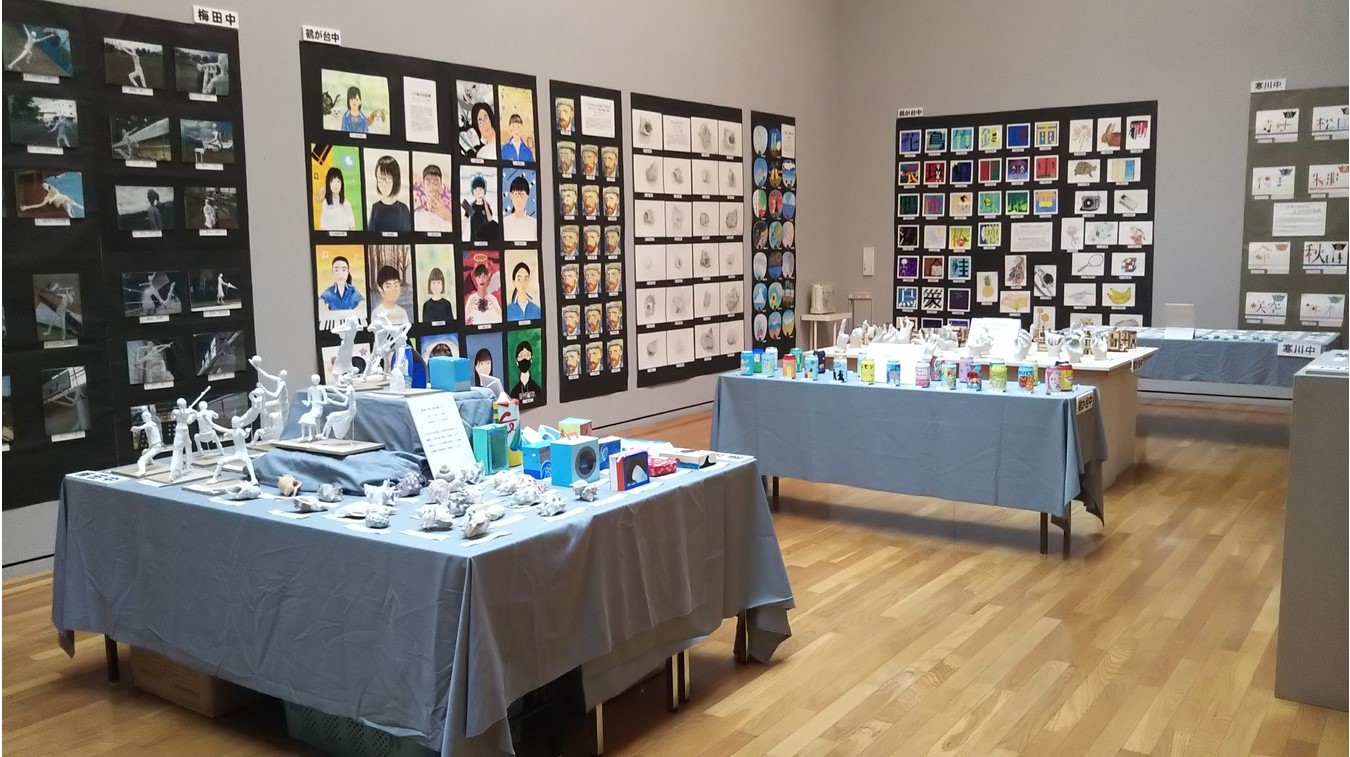
Art works by Junior high students in Chigasaki and Samukawa are being exhibited at the city museum. The exhibition is customarily held at the end of the year. These works were made in classes under various themes which had been allocated to each school. Many works show their great sensitivity.
The exhibition of clay animations by the students of Chigasaki support school "From hands to hands, 13 colored cray animations" is also underway at the museum.
The two exhibitions are going to be held until Dec. 10 (Sun). Admission free.
“Chigasaki just after WWII” shown in the diaries of Yasujiro Ozu and Kougo Noda at Chigasaki Peoples’ Museum.
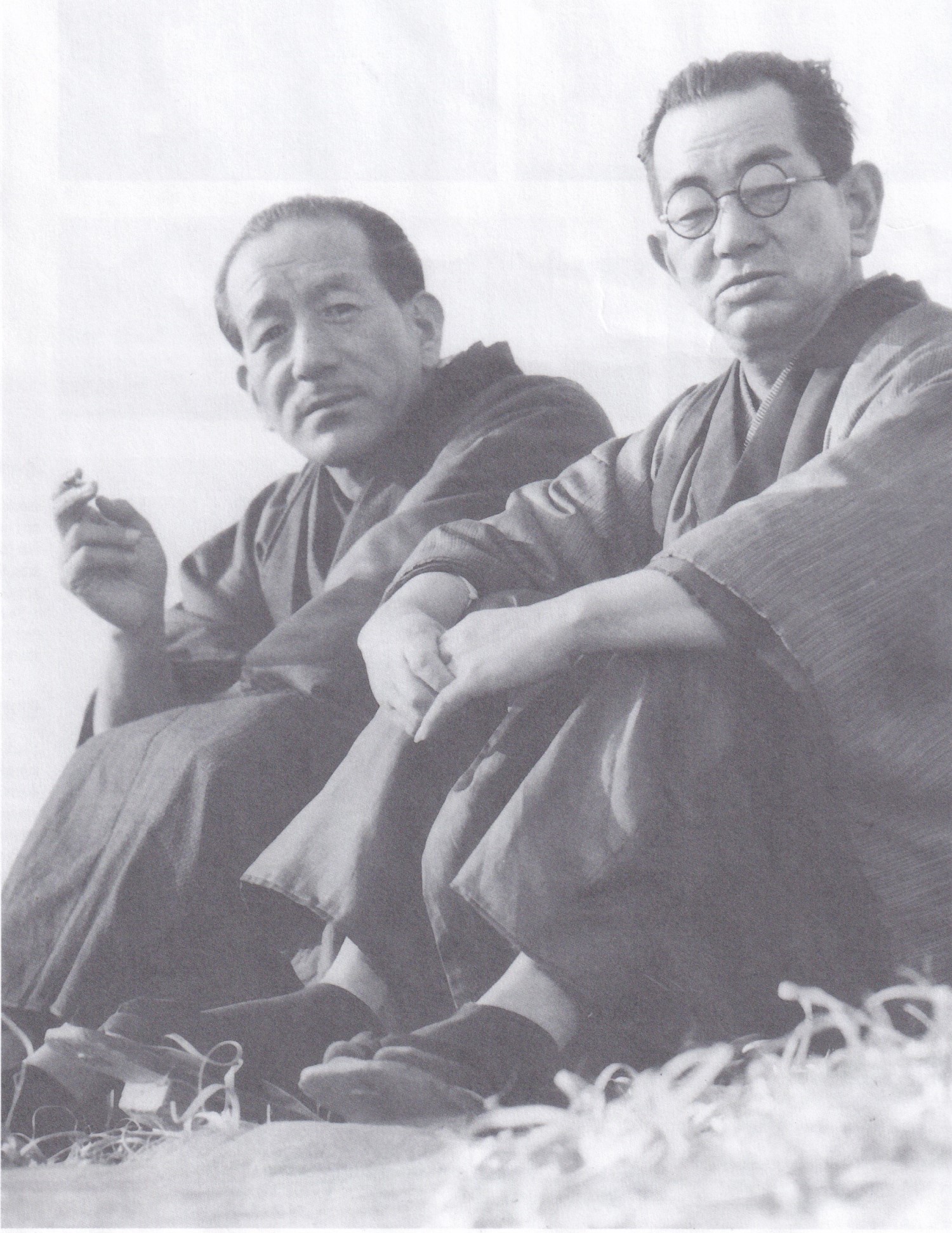
Film director Yasujiro Ozu (1903-1963) and screenwriter Kougo Noda (1893-1968) co-wrote “Bakushu”, or Early summer in English, at the Japanese-style hotel Chigasaki-kan. Based on people, places and meals in their diaries during the November 1950 to May 1951 period, everyday lives and the city’s atmosphere were investigated.
Ozu wrote down things intuitively with short sentences, while Noda recorded whom he met and what happened in detail by a time series. The diaries show differences in feeling and viewpoints between the two.
Year-end illumination
